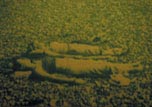February 7, 2003
Air Date: February 7, 2003
FULL SHOW
SEGMENTS
Water for Profit
View the page for this story
Over the past decade, an ever-growing number of people throughout the world have been getting their water from private, for-profit companies. Now, an international group of journalists has taken a hard look at this trend. Canadian journalist Bob Carty was part of that team, and speaks to host Steve Curwood about the downsides, even dangers, of water privatization. (10:30)
Technology Note/Toggle Science
/ Maggie VilligerView the page for this story
Living on Earth’s Maggie Villiger reports on a new development in nanotechnology, a surface that can toggle back and forth from water repelling to water attractive at the flip of a switch. (01:15)
Almanac/Gator Tales
View the page for this story
This week, we have facts about alligators in the New York City sewers. Urban legends be damned, a full-grown gator was pulled from an East 123rd Street storm drain 68 years ago. (01:30)
Pigs on the Run
/ Clay ScottView the page for this story
For years, wild pigs have been increasing in number and have taken residence in seventeen states across the country. Some people like to hunt them for game, but others are upset about the ecological and property damage they're causing. From California, Clay Scott reports. (10:10)
News Follow-up
View the page for this story
New developments in stories we’ve been following recently. (03:00)
Emerging Science Note/WTC Fallout
/ Jessica PenneyView the page for this story
Living on Earth’s Jessica Penney reports on how scientists are using the World Trade Center tragedy to study geology in the New York Harbor. (01:20)
White House Hydrogen Initiative
/ Anna Solomon-GreenbaumView the page for this story
Living on Earth’s Anna Solomon-Greenbaum reports on President Bush’s effort to push hydrogen fuel cell technology as the antidote for the nation’s dependence on foreign oil. (04:00)
Honda’s Green Car
/ Ingrid LobetView the page for this story
Living on Earth’s Ingrid Lobet talks with Robert Bienenfeld, a senior product manager with American Honda about the company’s fuel cell vehicle now being tested in Los Angeles. (04:30)
Grass Art
/ Maggie VilligerView the page for this story
You've heard of black and white pictures, but how about green and yellow? Artists Heather Ackroyd and Dan Harvey use live grass as a photographic medium. Living on Earth's Maggie Villiger reports on how they create their unique photos, and how collaboration with grass scientists is lending durability to their work. (07:10)
This week's EarthEar selection
listen /
download
Show Credits and Funders
This Week's Music
Show Transcript
HOST: Steve CurwoodGUESTS: Bob CartyREPORTERS: Clay Scott, Anna Solomon-Greenbaum, Ingrid Lobet, Maggie VilligerNOTES: Maggie Villiger,Jessica Penney
[THEME MUSIC]
CURWOOD: From NPR, this is Living on Earth. I’m Steve Curwood.
Water used to be plentiful and cheap, if not free. But not anymore. Now, big business sees a big opportunity in supplying this essence for life.
SPILLETT: It's a limited precious resource. The growth market is always going to be there, so it's a very reliable place to put your money.
CURWOOD: But in some places, private suppliers have prompted public outrage.
MILLER: This summer, we had multiple times where you would turn on the faucet and nothing would happen, sometimes for a couple hours, sometimes for a couple of days. And then when the water comes back it looks like dirty creek water.
CURWOOD: The business of water. We'll have a special investigative report. Also, it's not his father's Oldsmobile. George Bush champions the hydrogen fuel cell car.
We have those stories and more this week on Living on Earth, coming up right after this.
[NPR NEWSCAST]
ANNOUNCER: Support for Living on Earth's coverage of emerging science comes from the National Science Foundation.
[MUSIC]
Water for Profit
CURWOOD: Welcome to Living on Earth. I'm Steve Curwood. Over the past decade there has been a sharp rise in the number of people throughout the world who get their water from private companies. Critics of water privatization say it's dangerous to put the most vital of our resources into the hands of for-profit entities. But the companies argue that they're more efficient and cheaper than public utilities.
Now, the International Consortium for Investigative Journalists has just completed a year-long probe of this issue. We're joined now by producer Bob Carty with the Canadian Broadcasting Corporation. Bob was part of that international team and is a regular contributor to Living on Earth. Welcome, Bob.
CARTY: Hi, Steve.
CURWOOD: Now, tell me, just how big a phenomenon is this move towards private companies providing water?
CARTY: What we found in our research was that in 1990 private companies were delivering drinking water in just 12 countries around the world. Today they're in 56, at least. And if you throw in wastewater or sanitation service, they're in over 110 countries. If you had a McDonald's sign over the top of this industry, you would say, "More than 300 million served". That's the number of their customers around the world.
It's been a tremendous expansion just in a decade, and mostly by just three corporations. There's about six big ones, but three really large ones: Suez and Vivendi, both from France, and Thames Water from the United Kingdom, although it's, in turn, owned by RWE of Germany. They are some of the biggest corporations in the world and they've just, in recent years, gone beyond their homelands of France and the U.K. to be global players.
CURWOOD: And this expansion, is it just into the Third World?
CARTY: No, the companies are operating on every continent, including North America, where they're still small, maybe only 5 percent of the market. But they've already won contracts in places like Atlanta, Indianapolis, and Puerto Rico.
CURWOOD: Now, tell me why this network of journalists, the International Consortium for Investigative Journalists, decided that this was an issue that warranted scrutiny? What's the concern? What's the danger of having private companies supply water?
CARTY: I guess a number of people have certain philosophical concerns, to begin with. For example, in the United States, six out of the seven major players are foreign-owned companies and there's a question about having something as vital as water to everybody's life in the hands of foreign players. And some of these companies have budgets and income that are bigger than the budgets of some of the states.
In more concrete terms, we found some positive examples of privatization around the world, but a lot of negatives, too, Steve. I'll give you a few examples. In the Philippines, we found that the companies promised to really help the poor and they didn't deliver the promises. And one of the multinationals actually walked away from the Philippines quite recently because they weren't making enough profit.
In Jakarta, in Indonesia, we found that millions--tens of millions of dollars--ended up in the pockets of some of the cronies of the former dictator Suharto, with citizens of Indonesia wondering who benefits from privatization.
Here in Canada we found that there was major privatization, with huge cuts in staff, that was blamed for one of the largest—actually, the largest spill of sewage, raw sewage-- into Lake Ontario. And in South Africa, we found ten million people, almost a quarter of the population, have over the years had their water cut off because they couldn’t pay water at market rates. Everywhere we found less accountability with privatization, including in places like Atlanta.
CURWOOD: What happened in Atlanta?
CARTY: Well, a few years ago Atlanta decided it didn't have the money to invest in the future needs of keeping up its very old water system, so it put it up for tender. There was a competition, and Suez, through its subsidiary United Water, won the contract to run the drinking water system of Atlanta.
Now, this was supposed to be a showcase of what private companies could do, but it didn't turn out as promised. As you'll hear here from a couple of women from Atlanta, Lamar Miller and Walda Lavrof.
MILLER: This summer, we had multiple times where you would turn on the faucet and nothing would happen, sometimes for a couple hours, sometimes for a couple of days. And then, when the water comes back, it looks like dirty creek water. It clogs up all the filters in your refrigerator and it destroys your laundry.
LAVROF: There was a boil advisory out for water, and we didn't get the advisory until a day or two later. Which is serious business because if the water is not safe to use, as they said, for baby formula or for elderly, ill people, and so on, we should be notified at once, not a day or two later.
CARTY: And that's Walda Lavrof, and earlier, Lamar Miller of Atlanta.
CURWOOD: So what happened with this private water company in Atlanta?
CARTY: Well, the city did an audit of the private company and found that it wasn't collecting water bills sufficiently, it was delaying in repairs, it had bad customer service. It wasn't providing the city the savings that had been promised. For its part, the company just said that it didn't realize that Atlanta's pipes were so old and in such bad shape.
In any event, just a couple of weeks ago the two parties dissolved the contract. Atlanta water goes back to the public sector and the company, Suez, I suppose, has some egg on its face. But not enough damage to its reputation to prevent it from going in search of other contracts in the United States.
CURWOOD: Bob, when you think about big business expanding around the world, you think of sexy, high-tech industries, not something as humdrum as water utilities. I mean, it's the ultimate plain commodity, isn't it? What makes water such an attractive business?
CARTY: Have you ever played Monopoly, Steve?
CURWOOD: Oh, yeah.
CARTY: Okay. You know the strategy where you go after Boardwalk? You've done that. Get a hotel on it. There's another strategy, though, which is to buy up the utilities and the railways. They don't get as good a rent from the competitors going around the board, but people land on them all the time, every time around the board, and so you just keep raking in the money. It's stable and consistent.
Well, the water companies recognize this as a great long-term investment. Water is called the great unopened oyster, blue gold, the petroleum of the 21st century. The potential market, according to some estimates we found, is that the current market of about half a trillion dollars a year could grow to three trillion dollars a year.
And I have some tape from the water companies explaining their interest in water as a business. We'll hear first from a senior executive of the British company, Thames Water. He's Mr. Peter Spillett.
SPILLETT: Water is essentially a utility. Utilities are much safer than the high-risk stocks and shares. There's huge growth potential. We are worried about water resources in the future, about public access. We think there'll be world wars fought about water in the future. It's a limited, precious resource. So, the growth market is always going to be there, so it's a very reliable place to put your money.
CARTY: And those are the views of Peter Spillett of Thames Water. Views, Steve, that are very similar to those of Yves Picot. Yves runs the African operations for Vivendi, a French company. And Yves Picaud also feels water is a good business bet for the future.
PICAUD: I think it's because it's a stable one. It's a long term one, you have no surprise. One thing we are sure: everybody drinks water every day, or use water every day.
CARTY: And that's Yves Picaud for the Vivendi Corporation.
CURWOOD: Now, how have these water corporations been able to expand their presence around the world?
CARTY: Well, one way we found was that they got a lot of help from the World Bank. The World Bank as a development institution used to help poor countries build their own public waterworks, but they got criticized under the Reagan and Thatcher administrations for subsidizing the poor, for welfare mentalities. And the World Bank adopted, about ten years ago, a fairly free market approach.
And I have some tape on this from one of the World Bank's top water specialists. He is Menachem Lieberberg. He says the bank does support both public and private water services, that it's not ideologically in favor of one or the other, but you'll hear here there's a clear commitment to business. He's Menachem Lieberberg of the World Bank.
LIEBERBERG: I’ve found from my experience that ailing public utilities, it's basically impossible to improve them. You can put in all the money. The only way to get an ailing utility to work is through private sector. It's better handled by private companies because they have this business approach.
CARTY: And that's Menachem Lieberberg of the World Bank.
CURWOOD: Bob, how does the World Bank actually get countries to go the privatization route for water?
CARTY: Well, they use leverage through what they call conditionality, or tied loans. If you want our money, you have to do something in return. That kind of conditionality, we found in almost 60 percent of recent structural loans from the bank that it required privatization initiatives. The World Bank says it's just trying to get water to people, that it doesn't force itself--it doesn't force governments to privatize. But if you're a poor government and you get an offer of $200 million dollars to privatize and you get nothing if you don't, they see it definitely as a lot of pressure.
CURWOOD: Are there good public institutions to be supported here?
CARTY: Well, yes there are, and we found an interesting one in Bogotá. The utility there actually has won awards year after year for its water services. They provide really good services. They're helping more and more poor people, and they're doing it by getting the rich to subsidize the poor.
A couple years ago, they went to the World Bank in Washington to get a loan to help extend those services to more people, and the World Bank said no. They wouldn't loan them money unless they privatized and dismantled their subsidies. The Bogotá people, for their part, said no, and told the World Bank to keep the money.
CURWOOD: Now, what about the privatizations? Are there privatizations that work?
CARTY: Well yes, there are interesting examples we've seen in places like Cartagena, Colombia, and Casablanca, Morocco. Even in Manila, more poor people have some more water, though they haven't met the targets that were originally set down. Everywhere, though, we found people asking the question whether or not this could have been done, still, with a public utility. Did it have to go into private hands? Couldn't it have been done just as well by the public sector if it got some help?
CURWOOD: What are the business strategies for water corporations in the future, Bob?
CARTY: I talked to each of the three big companies about this over in Europe and they all have the same strategy, interestingly enough. They're going to keep their foundations in Europe. They're going to target two new areas. One is China and the other is United States, seen as the crown jewel for the private water industry.
CURWOOD: Bob Carty is a producer with the Canadian Broadcasting Corporation and a frequent contributor to Living on Earth. Hey, thanks, Bob, for filling us in.
CARTY: You're welcome, Steve.
CURWOOD: For more information on water privatization go to our website loe.org. That's www.loe.org.
[MUSIC]
Related links:
- The International Consortium for Investigative Journalism
water reports
- CBC water series
Technology Note/Toggle Science
CURWOOD: Just ahead, wild pigs on the rampage in California. First this environmental technology note from Maggie Villiger.
[MUSIC]
MAGGIE VILLIGER: In the field of nanotechnology, it's vital to be able to manipulate the properties of raw materials. Now, researchers at MIT have figured out how to control a surface's ability to attract and repel water.
The scientists constructed a thin gold surface covered with tiny perpendicular molecules. Their invention resembles a hairbrush lying on its back with the bristles pointing upwards, though these bristles are only about one billionth of a meter long. The ends of the bristles are negatively charged and attract water. But when the scientists apply an electric field to the gold surface, the bristle tips are attracted to the gold and bend over. And since the lengths of the arching bristles are positive, they now repel water.
The switch back and forth from water-attractive to water-repelling is easily reversible and repeatable. Scientists foresee using a surface like this one to deliver drugs to precise destinations in the body, or they could be used to sort proteins from a complex mixture of molecules. The researchers are currently working on ways to enhance the strength of the attraction and to figure out how the toggle idea could be applied to properties like adhesion, friction or bio-compatibility.
That's this week's technology note. I'm Maggie Villiger.
CURWOOD: And you're listening to Living on Earth.
[MUSIC: Thievery Corporation “Liberation Front” The Richest Man In Babylon, ESL Music (2002)]
Almanac/Gator Tales
CURWOOD: Welcome back to Living on Earth. I’m Steve Curwood.
[MUSIC: U2 “New York” All That You Can’t Leave Behind” Universal (2000)]
CURWOOD: Sixty-eight years ago this week, some New York teenagers launched an urban legend. While shoveling snow into an open manhole, the teens saw an eight-foot alligator struggling in the slushy water below East 123rd Street. They fashioned a lasso, and hauled the gator above ground. But it wasn’t a rescue with a happy ending. Eight feet of alligator is too much alligator for most people to handle. And the youths promptly killed it with their shovels. But the story did not die.
And while this incident is the only publicly documented sighting of an alligator in the New York sewer system, it has spawned many tales. Probably the most popular is the myth--you know you’ve heard it--baby gators brought back to the city from Florida as pets wind up getting flushed down the toilet when they start to show their teeth and their tempers. The yarn hit its stride in the 1930’s when none other than New York’s sewer superintendent Teddy May claimed he had seen and exterminated dozens of gators in the sewers.
Sewers may be the most swamp-like part of the city, but they are hardly good alligator habitat. It’s simply too cold and toxic down there. Still, the legend of the Gotham gators lives on, and not entirely without reason. Last summer, a smaller cousin of the alligator, called a caiman, mysteriously appeared in a Central Park pond. It was captured and placed in the park zoo.
So, the odds may be against them. But, after all, these crocodilians did survive the global disaster that killed the dinosaurs. Maybe they can survive New York, too. And, for this week, that’s the Living on Earth Almanac.
[MUSIC]
Pigs on the Run
CURWOOD: Of the hundreds of exotic animal species deliberately or inadvertently introduced to North America, the wild pig is among the most controversial. These animals can weigh upwards of 300 pounds. Some are descended from barnyard escapees, others from Eurasian wild boars that were introduced for hunting in the 1920’s.
Many are a mix and just about all of them are hardy, tough, omnivorous, and adaptable. For years, these swine have been increasing their range. And they’re now found in significant numbers in at least 17 states. Some hunters prize them as game. Others see them as an ecological nightmare. By far, the largest population of feral pigs is in California, as Clay Scott reports.
SCOTT: Portola Valley, California, in the oak-covered hills above Stanford University, is a community that prides itself on being close to nature. A town ordinance prohibits the building of fences between properties in order to ensure habitat corridors for wildlife. And people here enjoy the sight of daintily-stepping blacktail deer, California quail, and the occasional gray fox or bobcat.
But, one morning not too long ago, residents awoke to find that nature had come a little too close for comfort.
HOWARD: We started receiving phones calls from, first, property owners that their landscaping had been destroyed.
SCOTT: Angela Howard is Portola Valley’s town administrator. The culprits, she says, turned out to be a group of wild pigs literally eating their way through town.
HOWARD: The pigs migrated down behind the creek, and ended up eating up our soccer field. And I was really surprised at how much damage they can do in a relative short amount of time. It’s like someone had taken some sort of machinery and just dug up the whole field. It was just amazing.
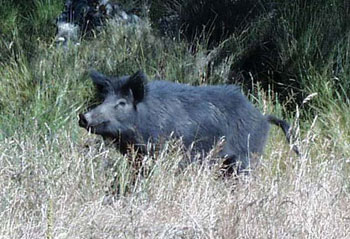
(Photo: Rick Sweitzer)
SCOTT: Overnight, the pigs also devoured lawns and flowerbeds, and dug up sprinkler systems. Not only did they cause physical damage, but many residents said they feared for their safety, and that of their pets. Even the animal-friendly town council of Portola Valley knew it had to take drastic steps.
HOWARD: When we had the discussion at the council level, it was pretty apparent that there was no way to relocate them. Nobody wanted them. We couldn’t keep them out by just fencing, although we talked about that. So, the decision was made to try to harvest them.
SCOTT: The man they hired to remove the pigs, Dick Seever, is remarkably good at his job. Probably no trapper on the west coast is in higher demand.
SEEVER: We have probably killed seven or eight thousand pigs since 1994. And that all was in 50 miles of San Francisco. There’s a lot of pigs in the area, or used to be.
SCOTT: Seever has been hunting and trapping California’s wild pigs for over 20 years. On a recent morning before dawn, he took me to a wooded ridge overlooking Silicon Valley and San Francisco Bay beyond. Seever has several current trapping contracts in this area. Among them, a county park and a film executive upset that the pigs have ruined his bonsai garden.
Here, where multi-million dollar houses lie hidden among live oak and sequoia, he set out half a dozen traps. He proudly shows me one of the homemade steel pens, 12x4x4, bated with a concoction of fermented corn mash so foul it makes you gag. To wild pigs, Seever says, it’s as enticing as the aroma of fresh-baked bread.
SEEVER: The trap is set just like that. The pipe is holding it up. And the pigs come through this corn. And they eat all this corn. And once they get all the way to the back of the trap, there’s a pulley and a string here. They get back to the trap. They hit this string. [SOUND OF DOOR SHUTTING] And at this time, they go kind of crazy for a few minutes. All the noise. They’re trying to get out. And then they calm down, and they eat all the feed. A lot of times, I come to the trap in the morning and they’re all in there sleeping.
SCOTT: Dick Seever has been hired by state, county, and municipal agencies, golf courses, airports, private residents, all of them desperate to get rid of wild pigs. For the most part, he works on the fringes of populated areas, checking his traps well before dawn.
Even people who are paying him to eliminate the animals, he says, prefer not to know exactly how he goes about his business. As for the general public, experience has taught him to keep a low profile.
SEEVER: I’ve had people cut my tires on my trailer. I’ve had people steal my traps. I’ve had all kinds of experience with people. But the animal rights people think that these pigs should live until they die. And, hey, if they were tearing up your back yard, it’s a different story. When it’s somebody else’s back yard, I guess it don’t matter.
SCOTT: Seever shoots the pigs in the trap using a .22 rifle. He used to donate the meat to soup kitchens and charities until health authorities cracked down, since the meat hadn’t gone through federal inspection. Now he delivers the carcasses to a tallow factory where they end up as soap, bone meal, and makeup.
His services are not only in demand in the suburbs, he was recently hired to trap pigs in Henry Coe State Park, 135 square miles of virtual wilderness southeast of San Jose. In three months last spring and summer, Seever killed 750 pigs. But park superintendent Kay Robinson says that number is only a drop in the bucket. She worries the pigs will do lasting environmental damage.
ROBINSON: We thought 750 would be a tremendous step in the right direction. But, every patrol that we’re out there in the park, we see more and more and more. So, the effect that they create on the landscape is going to affect California landscape many years down the line, primarily for the vegetation.
[SOUND OF BIRDS]
SCOTT: With its deep canyons thick with chemise and manzanita, and woodlands of blue oak and gray pine, Coe Park is home to hundreds of species of plants and animals, from mountain lions and tule elk, to rare plants and insects. It wasn’t that long ago that wild pigs were unknown here. Now, the park has mainland California’s highest density of the animals. And their impact can be seen throughout the ecosystem.
SWEITZER: On an annual basis, pigs are rooting up anywhere from 40 to 60 percent of the oak grassland, or the grasslands in this park.
SCOTT: Rick Sweitzer, a biologist from the University of North Dakota, has spent years studying California’s wild pigs. We hiked through an open oak savannah. And the pigs’ rooting is visible everywhere. Entire hillsides are scarred, hundreds of acres dug up as if roto-tilled. The pigs dig for grubs, worms, bulbs, roots and, above all, acorns. Their passion for acorns affects the ecosystem in many ways. They compete with native wildlife, and have been linked to the decline of species such as blacktail deer and western gray squirrels, which also depend on acorns.
Their rooting disturbs the habitat of ground squirrels, mice and other rodents that provide foot for predators. The torn-up ground also causes erosion, and speeds up the spread of exotic weeds such as star thistle which, in turn, choke out native grasses. And, biologists here are particularly worried about the pigs’ effect on the health of California’s blue oaks.
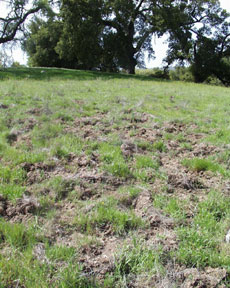
(Photo: Rick Sweitzer)
SWEITZER: It’s a high level of disturbance that’s been repeated year after year, to the extent that the seedlings that might be growing underneath these blue oak trees are going to be uprooted. And we’re going to see reduced oak regeneration and changes in plant communities, as a result of this repeated disturbance.
SCOTT: For the last three years, Sweitzer has been monitoring pig damage by means of exclosure plots, fenced in such a way that pigs are excluded, but deer and other animals can enter. Next to each exclosure is an unfenced control plot, and the contrast is striking. Within the fenced area, oak seedlings and native grasses grow. Outside, not a seedling is in sight. The soil is torn up. And signs of pig activity are everywhere; their pointed tracks, their droppings, and the dried gray mud they have rubbed on the trunks of oak trees. On this day, with so much evidence around, we knew it was only a matter of time before the animals themselves appeared.
SWEITZER (whispering): There’s a group of about 25 pigs on the hillside in the distance. And these guys are moving pretty fast. It looks like they’re heading somewhere with a purpose in mind.
SCOTT: The animals are about 400 yards away, black shapes conspicuous against the rich green winter grass. We decide to try and get closer. We duck out of sight below a low rise, and job for about 300 yards until we approach the meadow where we saw the pigs.
SCOTT (Whispering to Sweitzer): Hard to believe 20 animals could disappear that quickly.
SWEITZER: I’ll bet they went over that ridge right down there in front of us. Want to walk down there?
SCOTT: Sure.
[SOUNDS OF WALKING]
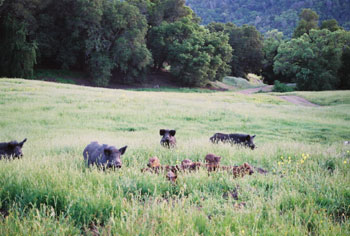
(Photo: Rick Sweitzer)
SCOTT: Suddenly, we come upon them less than a hundred yards away, sow and piglets feeding under a large valley oak. The wind is in our favor, so we sneak closer. We’re only a few yards away when two males emerge from the brush.
SWEITZER: That’s a big boar right there, the one with the foam coming out of his mouth.
SCOTT: How big is that one boar, would you say?
SWEITZER: I can see his scrotum. He’s a big male. He’s probably close to 320, 330 pounds. See, he’s challenging that other boar right there.
[SOUNDS OF PIGS]
SCOTT: Pigs have notoriously weak eyesight, but they can pick up movement. We don’t want to startle a cranky boar the size of a sumo wrestler with razor-sharp tusks. We finally decide 15 yards is not a prudent distance, and sneak away. Having observed the animals at close range, it’s obvious why no predator will tackle them once they’re full-grown. Even though mountain lions and coyotes do kill many piglets, Sweitzer says, the animals reproduce so quickly that neither predation nor hunting seems to make a long-term dent in their numbers.
SWEITZER: If it’s a good year, within a year they are going to be able to recover the numbers that they were before the control efforts started. And a good year would be a good, wet, year with a lot of acorns. And the numbers will just skyrocket. To really show a significant reduction in the amount of rooting that we’re seeing on an annual basis, you need to remove, at this point, 50 to 60 percent of the animals from the population.
SCOTT: That would require an intensive, costly, state-wide trapping effort, something that seems unlikely to happen. In the meantime, say biologists, pigs will thrive where ever there is suitable habitat. And California, with its millions of acres of oak woodlands, could not be more ideal for the animals. It’s far too soon to predict the pigs’ long-term impact on the environment. But, like the golden wild oats that cover the foothills in this state, another aggressive import from overseas--the wild pig--seems destined to be a permanent feature of the California landscape. For Living on Earth, I’m Clay Scott in Santa Clara County, California.
[ANIMAL SOUNDS]
[MUSIC: Kronos Quartet “Saade” Pieces of Africa Elektra (1992)]
CURWOOD: Just a few months ago, I was in the back of a Land Rover, driving across an African savannah under a crystal clear sky. As the sun was setting, we came across a solitary leopard trying to pull an antelope up into a tree. As we watched, we realized the leopard had a cub with her.
Now, our trackers had told us that these animals on the game preserves regard folks in Land Rovers as part of some relatively huge, benign animal. And, usually, they'll let you get close. But, this mom, with her baby and her antelope dinner, was in no mood for strangers. She walked right up to our truck and glared at us. A chill ran down my spine as I realized that we were just one swat away from her. And that would happen long before our tracker could grab the rifle on the dashboard of the Land Rover. I'll never forget the look in the leopard's eyes. She said, "This is my meat, my kid. I'm the boss."
Now, Living on Earth wants to give you a chance at your own African safari. Thanks to Heritage Africa, we're giving away a 15-day trip for two on the ultimate African safari, with visits to several of Africa's most spectacular game preserve, such as Krueger, where I saw this leopard, and the Serengeti.
For more details about how to win this 15-day African safari, just go to our website, loe.org. That's www.loe.org for the trip of a lifetime.
[MUSIC]
ANNOUNCER: Funding for Living on Earth comes from the World Media Foundation. Major contributors include The Ford Foundation, for reporting on U.S. environment and development issues, and The William and Flora Hewlett Foundation, for coverage of Western issues. Support also comes from NPR member stations and the Overbrook Foundation, working with the Natural Resources Defense Council to safeguard the earth, and the natural systems on which all life depends, and Bob Williams and Meg Caldwell, honoring NPR's coverage of environmental and natural resource issues, and in support of the NPR President's Council.
News Follow-up
CURWOOD: Time now to follow-up on some of the news stories we've been tracking lately.
A U.S. Court of Appeals in Richmond, Virginia has overturned a ruling that would have banned the dumping of coal waste into Appalachian rivers and streams. This debris is a byproduct of blasting away mountaintops to get at the coal underneath. Bill Raney is president of the West Virginia Coal Association.
RANEY: We're very proud of the way we have been mining coal in West Virginia over the last 25 to 30 years. And we have study after study that indicates that there is a minimization to any impact on the environment. And the long-term impact to the environment is negligible.
CURWOOD: Since the ruling, about 100 new coal mining permits have been submitted to the Army Corps of Engineers for approval.
[MUSIC BUTTON]
CURWOOD: After an extensive analysis, the EPA has announced that the most common herbicide in the country may continue to be sprayed over cornfields and lawns. Atrazine at levels of one-part per billion can cause malformations in frogs. The acceptable level in drinking water is now set at three times that.
The Agency has asked the herbicide's main manufacturer, Syngenta, to monitor drinking water for atrazine. But according to senior scientist Jessica Sass of the Natural Resources Defense Council, these measures are not aggressive enough.
SASS: Atrazine, at this point, is already banned or severely limited in its use in a handful of European countries, including Syngenta's home country of Switzerland. So, it would certainly not be going out on a limb for the U.S.A. to announce that it was banning atrazine uses in this country.
CURWOOD: The EPA plans to complete an assessment of the effects of atrazine on amphibians later this year.
[MUSIC BUTTON]
CURWOOD: President Bush recently announced that the U.S. will go ahead with plans to participate in the International Fusion Research Project known as ITER. Robert Goldston is director of the Princeton Plasma Physics Lab, funded by the Department of Energy. He says the move is good for science and the economy.
GOLDSTON: If the U.S. is going to be a competitive seller of fusion energy on the world market, it's a requirement that we accelerate our efforts on the science and the technology of fusion so that the U.S. has the best ideas and the best capabilities when the time comes.
CURWOOD: The U.S. pulled out of the project in 1998, citing the $10 billion dollar high price tag. Since then, the estimated cost has been cut in half.
[MUSIC BUTTON]
CURWOOD: And finally, the late drug lord of Colombia probably wouldn't have chosen to leave his estate to roaming hippos. But, ten Nile hippopotami, weighing two tons each, have staked their claim. They are the last remnants of Pablo Escobar's private exotic zoo. According to hippo experts, the animals are flourishing and can be seen late at night roaming the abandoned ranch in search of food and fun. And that's this week's follow-up on the news from Living on Earth.
[MUSIC]
Emerging Science Note/WTC Fallout
CURWOOD: Just ahead, a look at the car the President says a child born today will someday drive. First, this Note on Emerging Science from Jessica Penney.
[MUSIC]
PENNEY: When the World Trade Center collapsed on September 11, 2001, it covered lower Manhattan in ash and left a layer of sediment at the bottom of the Hudson River. Scientists now hope that this ash layer may help them learn more about the geology of the New York Harbor.
A team of researchers from University of Massachusetts in Boston took river-bottom sediment samples at two unused piers on the lower west side of Manhattan one month after the disaster. They found unusual concentrations of calcium, strontium and sulfur. These are all elements found in gypsum drywall and in ash from the Twin Towers.
They are still trying to determine how much of the ash fell from the sky onto the river, and how much washed into the water after rainstorms later in September. This distinct layer of chemicals could wash out to sea. But the researchers say it may remain on the bottom of the river and become a permanent geological marker of the tragedy.
Having a clear and distinct sediment layer from a specific event will allow the researchers to learn more about the movement of particles in the harbor. The researchers went back to the Hudson last July and took more samples from different locations. They are analyzing the data and what they say will become an ongoing effort to monitor the fate of the World Trade Center ash. That's this week's Note on Emerging Science. I'm Jessica Penney.
[MUSIC]
CURWOOD: And you're listening to Living on Earth.
[MUSIC: Antonio Pinto/Ed Cortes “A Transa” City of God Milan Records (2002)]
White House Hydrogen Initiative
CURWOOD: It's Living on Earth. I'm Steve Curwood. President Bush recently trotted out one of the environmental themes from his State of the Union address.
At the National Building Museum in Washington, D.C., he showcased the administration's 1.2 billion dollar commitment to speed development of hydrogen fuel cell technology. Mr. Bush says fuel cells are crucial to reducing our dependence on foreign sources of energy. Living on Earth's Anna Solomon-Greenbaum was there and has our story.
PRESIDENT BUSH: We're talking about fuel cells today. Energy independence. Clean air…
SOLOMON-GREENBAUM: Behind a large ring of tall blue velvet curtains, President Bush took a stroll among the latest gadgets in fuel cell technology. When, at last, he emerged onto the stage outside, he told his audience what he had seen.
PRESIDENT BUSH: When you walk around this curtain, and you take a look at those vehicles, they are going to run on hydrogen. We saw cell phones that can run on hydrogen, laptop computers. There is going to be all kinds of applications for the use of hydrogen-powered fuel cells in our society.
SOLOMON-GREENBAUM: Many obstacles remain, said the President, including building the infrastructure to store the hydrogen and deliver it to fuel stations. It might be almost 20 years, he said, before the first hydrogen cars are available on the commercial market. But those cars, he said, will mean cleaner air and fewer greenhouse gases. And, the President said, hydrogen will help free us from dependence on our enemies.
PRESIDENT BUSH: We import over half of our crude oil stocks from abroad. And sometimes we import that oil from countries that don't particularly like us. It jeopardizes our national security. If we develop hydrogen power to its full potential, we can reduce our demand for oil by over 11 million barrels per day by the year 2040. [APPLAUSE]
SOLOMON-GREENBAUM: The President called on Congress to authorize $1.2 billion dollars to fund the fuel cell program. But some lawmakers, like Senator Byron Dorgan, a Democrat from North Dakota, said the President isn't asking for enough.
DORGAN: The President's suggestion is a step in the right direction, but it's a baby step. And frankly, he talks about $1.2 billion dollars, but most of that is not new money.
SOLOMON-GREENBAUM: Senator Dorgan has written his own proposal. It would funnel $6 billion dollars over ten years into fuel cell development. The senator wants to see 100,000 hydrogen fueled cars on the road by the year 2010.
DORGAN: We need to set kind of a moon shot goal out there and decide as a country we're going to meet the goal.
SOLOMON-GREENBAUM: Many environmental advocates are wary of all this lofty talk about a future in fuel cells. They worry it's becoming a substitute for reducing our oil consumption today. Wesley Warren is with the National Resources Defense Council. He says tougher fuel efficiency standards now could cut air pollution and oil consumption in half by the time the first fuel cell cars hit the road. And fuel cells, he says, aren't actually pollution-free. It takes other energy to make the hydrogen in the first place. Warren says the President's new budget includes an earmark for nuclear power specifically geared to produce hydrogen.
WARREN: We don't think that it makes sense to be going down a nuclear path for cars of the future when we could have tremendous payoff in investments in solar and wind technology that could provide the hydrogen fuel in a way that's clean and affordable for the future.
SOLOMON-GREENBAUM: Warren says these renewable energies lose out in the President's new budget. That budget, including the President's fuel cell proposal, is now being considered in Congress. For Living on Earth, I'm Anna Solomon-Greenbaum in Washington.
Honda’s Green Car
CURWOOD: And now to California, where some of the first fuel cell technology is already on the road. Japanese automakers Toyota and Honda delivered a handful of fuel cell cars to the University of California and the City of Los Angeles last December to test in everyday driving.
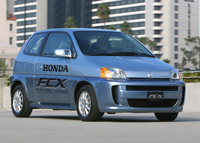 |
 |
|||||||||||
| Honda FCX Fuel Cell Vehicle | GM’s Hy-wire Fuel Cell Vehicle
Southern California already has at least eight hydrogen filling stations. And a dozen more are in the works. The H2 mobiles are in high demand these days. But, Living on Earth's Ingrid Lobet caught up with one Honda FCX, and with Robert Bienenfeld, senior manager for American Honda product planning, to talk about the fuel cell future.
BIENENFELD: Why don't we pop the hood? LOBET: So, I don't see anything I recognize; no cylinders, no distributor cap, no battery, no spark plugs. Can you tell us how it works? BIENENFELD: Sure. Here, what we have is an electrochemical reaction where we mix hydrogen and the oxygen in air together. And, chemically, we create electricity. And the exhaust is just water vapor. LOBET: Now, the President said in his State of the Union Address last week, that it was his hope that a child born now could have, as his or her first vehicle, a fuel cell car. That's 16 years away. Do we have to wait that long to buy one of these? BIENENFELD: Well, we think that's actually a good estimate. And there are a lot of hurdles to overcome for mass production and making it available in a showroom. Hurdles like the infrastructure issues. How do you make hydrogen cleanly? And, how do you distribute it to consumers? LOBET: Can you see a day in the near, the foreseeable, future when you might be able to sell one for 20, $25,000 dollars? BIENENFELD: Well, of course, that's our dream. And, we're taking several steps to achieve that dream. And it's not just building a fuel cell vehicle powered by hydrogen. It's also working with clean gasoline vehicles. Because clean gasoline vehicles teach us about catalyst technology. Catalysts are core technologies for fuel cells. LOBET: We know that hydrogen doesn't just occur out here in the atmosphere or on the Earth the way we might wish that it did. We have to use energy either from nuclear plants, or coal, or perhaps the sun, to separate it from other molecules. How are you getting the hydrogen that's running this vehicle? BIENENFELD: Well, this vehicle is being fueled at a station which is taking photovoltaic technology and converting sunlight into electricity. The production of hydrogen is one of the key issues. After all, if we don't make hydrogen cleanly, we haven't really accomplished a lot. Fuel cells, depending how we make the hydrogen, can be clean, can be an improvement in CO2. But they absolutely are a solution for fuel because we can make the fuel from a number of sources; grasses, making grasses into ethanol, ethanol into hydrogen, many different ways we can do it. And that's what's being researched now. LOBET: Switching away from the internal combustion engine is going to be such a shift for the American psyche. What are your plans for helping Americans make that shift? BIENENFELD: I think, while Americans have a great love affair with automobiles, what they really crave is mobility. We know how people respond to horsepower, and torque, and all the little amenities on a car, and the packaging. But, these are really new and exciting areas to explore. For example, with an electric vehicle like a hydrogen fuel cell vehicle, they can operate in a much more quiet environment. How do people value that? If you don't go to a gas station, if you could refuel at home, how do people respond to that? Is that a value? In the United States, the value of our time in going to a gasoline station may far outweigh the cost of the fuel. So, by making these baby steps, we can learn a lot about what will drive consumer behavior in the future, and how we can successfully launch hydrogen fuel cell vehicles. CURWOOD: Robert Bienenfeld, senior manager for American Honda product planning, speaking with Living on Earth's Ingrid Lobet in Los Angeles. You can see photos of the Honda FCX and other fuel cell vehicles on our website. That's loe.org.
Grass ArtCURWOOD: Color or black and white. Glossy or matte. These are the options most of us are familiar with when we drop off a roll of film to be developed. But British artists Heather Ackroyd and Dan Harvey have other things to keep in mind when developing their photos, like how much water and fertilizer they'll need. Living on Earth's Maggie Villiger explains. VILLIGER: Up close, it looks like a dried out lawn. But take a few steps back and an image starts to come into focus. It's a photograph of a mother and child, six feet tall, four feet wide. And believe it or not, the picture is made from growing grass. In a darkened studio, a new grass photograph is under production. HARVEY: Just in here, behind the plastic…it’s not a very wide space… Dan Harvey leads the way inside a makeshift tent of heavy black plastic. A canvas of live grass seedling sits on an easel. Humming a few feet away is a slide projector that provides the only illumination. It shines a beam of light through a photograph negative onto the baby grass. HARVEY: And if I stand in front of the projector and put a flashlight on, you can just see the imprinted image now is becoming apparent. But it's still quite early days. I think, by tomorrow, we'll be probably with the image stamped in. ACKROYD: Yeah. Ooh. It's doing pretty good, isn't it? HARVEY: Yeah, I see the imprint. ACKROYD: Yeah. VILLIGER: Heather Ackroyd and Dan Harvey are grass artists. They started out covering ancient trees, whole rooms, and entire building facades with lush, green carpets of newly seeded grass. Then, about ten years ago, at one of their installations, inspiration struck.
|





